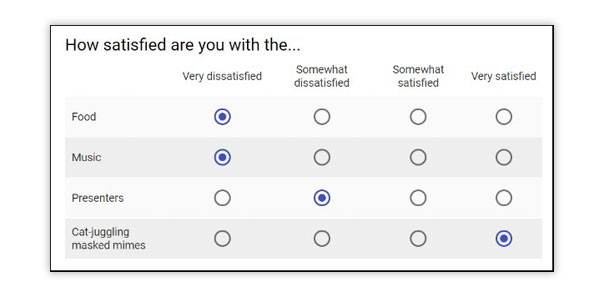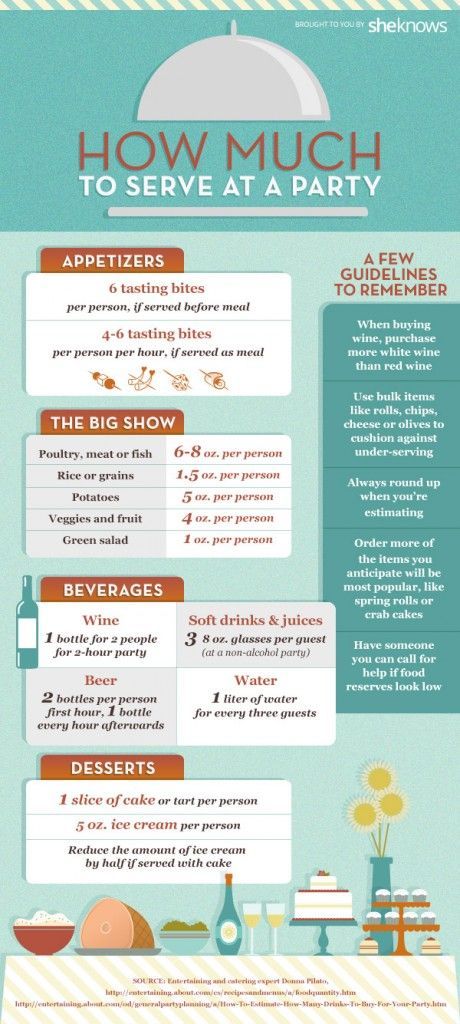6 Steps to Determine How Much Food to Order for Your Event
Did you know that 77% of people say that food is important when they attend an event?
80% admit that they would return to the same event next year if the food was delicious.
People love food. And — while taste is definitely important — you need to make sure you have enough food for all of the people attending.
From theme parties to award ceremonies and weddings, here’s how you can figure out how much food your event needs.
1. Do a manual count
 The first (and easiest) step is to simply count how many people are attending your event and multiply that by your serving size.
The first (and easiest) step is to simply count how many people are attending your event and multiply that by your serving size.
For example, if you have 300 guests coming and you plan on serving each guest 1 chicken breast and 1 baked potato, you would need 300 chicken breasts and 300 potatoes.
Simple enough, right?
Well... sort of.
You have to account for waste.
So, if you order 500 tomatoes, you can bet that some of them will be spoiled. But what if you want to serve a bunch of small things and you don’t know who will pick what?
After all, 50% of event-goers prefer to sample small servings instead of eating a large meal.
2. Leverage vendor insights
When it comes to figuring out how many small appetizers to prepare for a large crowd, lean on your vendors.
Food vendors guac!
They know what to do.
Food caterers and vendors are used to the madness of events. Just make sure that you pick vendors who can handle your event audience.
A recent Inc. post interviewed food vendors at Coachella and if there’s one thing we’re certain of, it’s that these vendors know how to handle a crowd and keep them fed.
There’s A LOT that goes into catering big events. That’s why Shawna Dawson — the event planner for Artisanal LA — said that “A lot of time was spent on bringing in the right vendors who’d be appealing to festival goers.”
It’s not just about their combination of foods or the taste of their foods, you need to make sure that they have experience with your event type to help you come up with portions and buy the accurate amount of food.
|
Check registration off your list Request a demo now to set up, create and start selling |
3. Always round up your orders
When in doubt, round up.
If you think you need 100 lbs. of fish, buy 110 lbs. Sure!
You don’t want to waste any food (America wastes an absolutely insane amount of food), but you also want to make sure that your attendees don’t walk away hungry and that everyone is hap-pea.
That means that you should round up, but not over buy.
You want a little breathing room, but not enough that you end up wasting a ton of food (and cash).
4. Remember your budget
We’re not trying to get jalapeño business, but it’s time to talk about money.
Sure!
We all want to buy our attendees lobster and steak.
But we can’t.
When you plan your menu, don’t overspend on expensive ingredients and risk running out of budget to buy an adequate amount of food.
Cheap food can still taste really good in the right hands. You don’t have to spend a pretty penne to satisfy your guests, but you do need to have the right amount of food.
5. Take post-event surveys
This isn’t going to help you during your current event, but giving attendees post-event surveys can help you during your next event.
Your attendees know whether they had enough food or not. If you see cards starting to complain about quantity or even quality, you need to get more food next time.

This is also a good place to make sure that everyone had a good thyme. See if your event left them s-peach-less or if they thought it could be butter. Once you know where your problem areas are, you can fix them.
It may sound corny, but simply asking people usually works. Sure! You can spend tons of time and money doing market research. But why not just ask? It prevents you from rebeeting the same mistakes.
|
Build custom reports and manage data Get real-time alerts, a breakdown of your |
6. Establish a Serving Size
How much food are you going to serve each person?
This is where your vendors can come in handy, if they follow portions sizes correctly. If you’re at the point where you cannoli take a rough guess when it comes to serving sizes, ask around.
You don’t want to end up calculating the right amount of food but not the right serving sizes that are expected.








